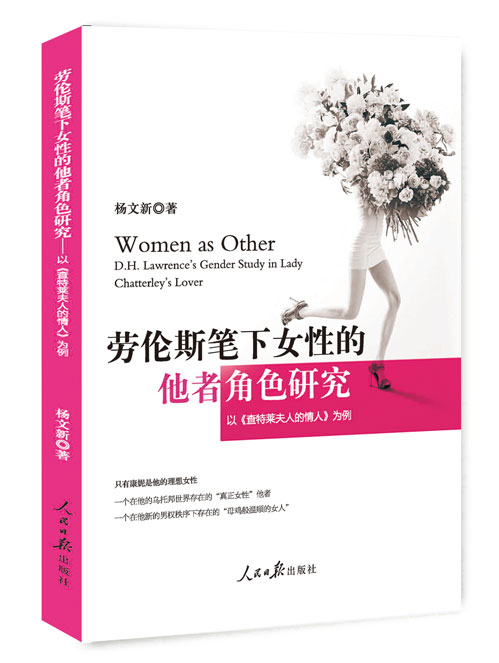
作者单位:德宏师范高等专科学校
出版时间:2018年5月第1版第1次印刷
本书概述:本书属于文学研究学术著作。借用波伏娃和黛儿黛儿?斯彭德的女性主义观点,以世界名著劳伦斯的《查特莱夫人的情人》一书为研究对象,分析了这部小说中的五位女性角色,基于对五位女性的性格分析与讨论,提出男人与女
作者姓名: 杨文新
出版社: 人民日报出版社
订购电话:400-6677-036
优惠活动:出书作者购书享受65%折优惠。
购书服务:满59免运费 : 由一站出版网发货,并提供售后服务。6:00前完成下单,预计5天可送达
图书定价:45
内容简介
本书属于文学研究学术著作。借用波伏娃和黛儿黛儿?斯彭德的女性主义观点,以世界名著劳伦斯的《查特莱夫人的情人》一书为研究对象,分析了这部小说中的五位女性角色,基于对五位女性的性格分析与讨论,提出男人与女人的和谐发展应当合作、建立双赢关系,而不是劳伦斯所主张的通过斗争理论来平衡两性。
作者简介
杨文新 女,汉族,云南保山龙陵人,本科毕业于云南大学外国语学院英语系,获学士学位;毕业后在德宏师范高等专科学校外语系任教《综合英语精读》《英语阅读》《大学英语》等课程;2010-2013年就读于云南师范大学外国语学院,获英语语言文学硕士学位,后继续任教于德宏师专外语系。期间公开发表教学论文8篇、学术论文10篇,参与课题研究3项,主持课题研究1项。主要研究方向:英美文学和英语教学。
Acknowledgementsⅰ
Abbreviationsⅱ
Prefaceⅲ
前言ⅶ
Comments on the StudyChapter One Introduction
1.1 Lawrences Triplet (Experiences,philosophy and Works)
—Pursuing the Significance of Male
1.2 Lady Chatterley’s Lover
1.3 Significance of the Study
Chapter Two Literature Review
2.1 International Studies
2.1.1 Criticism from Male Critics
2.1.2 Criticism from Female Critics
2.2 Domestic Studies
2.3 Summary
Chapter Three Introduction to Theories
3.1 Beauvoir‘s “Woman as Other for and by Men”
3.2 Spender’s “Patriarchal Order”
Chapter Four Women in the LCL
4.1 Women as Other for Men in Lawrences Patriarchal Order
4.1.1 Connies Mother— A “Cocksure Woman” as Other for Men in Society
4.1.2 Hilda—A “Cocksure Woman” as Other for Men in Spirit
4.1.3 Bertha Coutts— A “Cocksure Woman” as Other for Men in Sexuality
4.2 Women as Other by Men in Lawrences Patriarchal Order
4.2.1 Mrs.Bolton— Not a “Cocksure Mother” but an Absolute Other by Men
4.2.2 Connie— A “Hensure Woman” as an Absolute Other by Men
4.3 Lawrences Gender Views
Chapter Five Conclusion
5.1 Findings of the Study
5.2 Reflections on Gender Equality
……
Chapter One Introduction
David Herbert Lawrence (1885-1930) is a prolific writer of the twentieth centuryDuring more than two decades of his writing,there are 14 novels (including 3 versions of Lady Chatterley),over 60 tales,11 complete volumes of poetry,10 plays and 14 nonfiction books (Popawski 211-214)He is highly claimed not only as a novelist,novella and short writer,but also as a poet,essayist,translator,dramatist and painterWhen compared to Ezra Pound,TSEliot,James Joyce and Virginia Woolf,Lawrences position on the literary map “at times,seemed far less secure than them” (Fernihough,“introduction” 3)In his books and essays,he expressed freely his extreme ideas on politics,marriage,society,education,religion and man and woman,often by narrating sexualitySo “everyone feels the need,at the outset,either to like him or to dislike him”(Torgovnick 33)
To those who like him,he is a genius,prophet and cultural iconEMForster calls him the greatest novelist of his generationFRLeavis devotes all his life to supporting him,making him become the ‘canon’ of English literature and appear with increasing frequency in school and university curricula in the 1950s (Fernihough,“introduction”4)Later,Raymond Williams and Richard Hoggart from proletarian backgrounds view him as “the sole workingclass hero of modern English literature”(Baldick 263)
To those who dislike him,he is one of the most controversial writersAs Eliot sums up,“Lawrences life as a story of spiritual pride,emotional sickness,selfdeception,and a kind of ignorance that would not have been remedied by an Oxbridge grooming” (qtdin Baldick 257)Feminists also attacks him more bitterly not only for his statement in a letter that his work for women would be “better than the suffrage”,but also for the misogyny of much of his work (qtdin Milne 200)Meanwhile,as a twentiethcentury writer,Lawrence was and is usually seen as being marginal to the modernism,for those socalled mainstream writers like James Joyce and Virginia Woolf were almost uniformly hostile or condescending to him,but his apparently marginal position promotes him to “critically central” writer (Bell 179)
……








